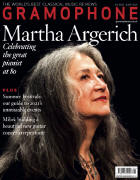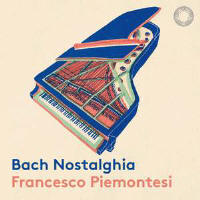Texte paru dans: / Appeared in: |
|
|
Outil de traduction (Très approximatif) |
|
|
Reviewer: Jeremy Nicholas The best piece of advice I ever got when starting out as a broadcaster was from the great Michael Oliver, late of this parish. ‘Don’t sell,’ he said after I’d done a trial run of my script. ‘Offer.’ It is advice from which Francesco Piemontesi might have benefited for, right from the first notes of the Bach-Busoni St Anne Prelude, BWV552 (the Fugue is placed as the final item on the disc), the playing is fullon, strident and, in many passages, not particularly easy on the ear. Throughout the programme I was, I’m afraid, drawn to comparisons with others and left in no doubt as to my preferences. Piemontesi’s insistent treble against a cathedral rumbling of a bass is a characteristic feature. Compare Edwin Fischer’s voicing in BWV552, recorded in 1933, with its top line singing effortlessly above a cushioned support. In Wachet auf, using a different version to the familiar score (the newcomer has a da capo repeat halfway through and some fussy harmony additions to the right hand), Piemontesi thunders noisily to the end despite Busoni’s semplice request, one adopted to advantage by Hannes Minnaar (Cobra, 1/14). The next transcription is Wilhelm Kempff’s popular arrangement of the Siciliano from the Flute Sonata, BWV1031 (heard more frequently like this than in its original form). One is never unaware of the piano being a percussive instrument here, unlike Dinu Lipatti’s suave 1950s classic. The same is true of the enjoyably perky and quite unfamiliar transcription of Kommst du nun, Jesu, vom Himmel herunter, BWV659, by Maximilian Schnaus. Then, somewhat anachronistically in this company, comes Busoni’s mighty Toccata. Piemontesi is fully equal to its fearsome technical demands and builds to a thrilling conclusion. Marc-André Hamelin offers an alternative view with a more refined and lucid touch in his survey of Busoni’s late piano music (Hyperion, 11/13). The only original work of Bach here is the Italian Concerto. In this, Piemontesi abandons his magisterial quasi-organo sonorities and presents a jaunty account with sparkling part-playing, though always coloured by his rather lemony tone. For me, preferable are Katsaris (Sony, 1/96) and, perhaps surprisingly, Solomon in a 1956 RIAS radio broadcast (APR, 4/95). Not far behind him in the magisterial sonority stakes comes Emmanuel Despax and his hyphenated Bach programme. Despax, it must immediately be said, benefits from a superior sound recording (Andrew Keener, Robin Hawkins and Simon Eadon), a more sympathetic acoustic (Wyastone, except for two tracks) and the burnished-gold tone of a Fazioli 278, an instrument that is not exactly underpowered. Despax coaxes sounds from it in the quieter pieces that generally elude Piemontesi, even inviting comparison with Emil Gilels in Siloti’s mesmerising take on Prelude No 10 from The Well-Tempered Clavier. Ich ruf’ zu dir, Herr Jesu Christ is as soulful as you’ll ever hear it. Wachet auf is the only piece in common with Piemontesi. Despax plays this beautifully in the same manner as Minnaar (above). But elsewhere significant differences in approach to this repertoire emerge. Compare the Dutchman, for instance, and his fleet, delicate touch in Nun freut euch, with Despax, no less athletic but scarcely Busoni’s leggiermente to the extent of making it sound like a toccata in panic mode. He opens with Saint-Saëns’s tasteful treatment of the Sinfonia from Cantata No 29, rechristened ‘Ouverture’, and with driving, well-defined quaver bass octaves underpinning the relentless treble semiquavers. Superb. It is the four big works that cause me to raise an eyebrow. Perhaps one would not notice it as much hearing them separately in the contrasted company and textures of other composers’ voices, but in the BachBusoni Chaconne, the Bach-Liszt Prelude and Fugue in A minor and especially the two Szántó transcriptions, the Fazioli is pushed relentlessly to the considerable limits of its dynamic range. Page after page of bombastic ff and fff becomes wearisome after a while, much as one can thrill to a martellato rattling of the Fazioli’s lower bass notes. For me, Michelangeli and Stephen Hough (his recent Hyperion recording – 2/21) in the Chaconne, and Hannes Minnaar again (or Byron Janis in his airy, much faster account from 1947) in the Bach-Liszt are more gratifying on the ear. Though I was grateful to be introduced to the rarely heard Szántó transcriptions, formidable in their ambition and technical challenges, I prefer their pages of fortissimo magnificence in their original garb. In the end, it comes down to whether you favour Bach transcriptions translated to the aural qualities of the pianoforte or attempting to mimic a cathedral instrument. Or, to put it another way, do you prefer your hyphenated Bach sold or offered? |
|




